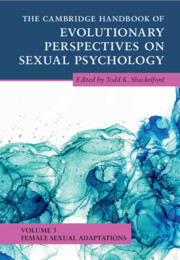Book contents
- The Cambridge Handbook of Evolutionary Perspectives on Sexual Psychology
- The Cambridge Handbook of Evolutionary Perspectives on Sexual Psychology
- Copyright page
- Contents
- Contributors
- Preface
- Part I Precopulatory Adaptations
- 1 Women’s Preferences: Precopulatory Adaptations
- 2 Female Sexual Attraction Tactics
- 3 Extra-Pair Sexual Interest
- 4 Female Intrasexual Competition
- 5 Female Intersexual Selection
- 6 Evolution of Precopulatory Defense from Rape and Coercion in Women
- 7 Mate Poaching
- Part II Copulatory Adaptations
- Part III Postcopulatory Adaptations
- Index
- References
5 - Female Intersexual Selection
from Part I - Precopulatory Adaptations
Published online by Cambridge University Press: 30 June 2022
- The Cambridge Handbook of Evolutionary Perspectives on Sexual Psychology
- The Cambridge Handbook of Evolutionary Perspectives on Sexual Psychology
- Copyright page
- Contents
- Contributors
- Preface
- Part I Precopulatory Adaptations
- 1 Women’s Preferences: Precopulatory Adaptations
- 2 Female Sexual Attraction Tactics
- 3 Extra-Pair Sexual Interest
- 4 Female Intrasexual Competition
- 5 Female Intersexual Selection
- 6 Evolution of Precopulatory Defense from Rape and Coercion in Women
- 7 Mate Poaching
- Part II Copulatory Adaptations
- Part III Postcopulatory Adaptations
- Index
- References
Summary
Relative to other species, human females invest considerable effort in attracting and retaining mates. Stroll the aisles of any bookstore and you may come across titles such as “Get the guy: Learn secrets of the male mind to find the man you want and the love you deserve” (Hussey, 2014), and “Texts so good he can't ignore: Sassy texting secrets for attracting high-quality men” (Bryans, 2018). A desire to attract and retain mates underlies diverse facets of women’s psychology and behavior, including displaying or enhancing aspects of one’s personality and physical appearance. Not surprisingly, these efforts correspond with men’s mate preferences. Human males are unique in their relative choosiness surrounding their mates, especially within the context of long-term pair-bonding. Look further in that bookstore aisle and you might come across a title such as “The man's handbook for choosing the right woman” (Daniels, 2009). In this chapter, we examine the theoretical rationale underlying female intersexual selection. We begin with a discussion of the theory underlying human mate choice, highlighting why men’s choosiness has been selected for, and why this compels women to exert effort toward attracting men. We then discuss specific characteristics of men’s short-term and long-term mate choice, and the multitude of tactics women utilize to better embody those traits. We describe preliminary evidence surrounding how intersexual selection may have shaped some phenotypic traits in women as costly signals of underlying fertility or immunocompetence. Finally, we discuss both individual and contextual differences among women in their mating effort and provide suggestions for future research directions aimed at further understanding how intersexual selection has shaped women’s mating psychology.
Keywords
- Type
- Chapter
- Information
- Publisher: Cambridge University PressPrint publication year: 2022



